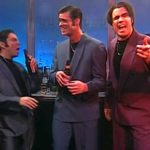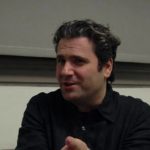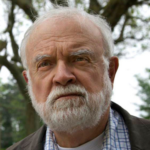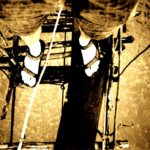Harry S. Pariser is a writer, publisher, photographer, graphic artist, and artist living in San Francisco. He is originally from southwestern Pennsylvania and graduated from Boston University. He has traveled widely in North America, the Caribbean, Central America, Europe, Africa, and Asia. He speaks Japanese, Indonesian, and Spanish in order of fluency. His interests include hiking and backpacking, reading, movies and cultural events, cooking, and politics and economics.
How did you get started traveling?
I think I became interested in travel at an early age because my parents had a subscription to National Geographic, so I really enjoyed the photos and maps. I also read Treasure Island and other books. Travel appeals to imaginative children.
I first started traveling just before I went to college. It was relatively inexpensive to go to Europe and travel around. I went to Morocco. I remember being up on a roof with another young traveler who had a bottle of Jack Daniels and looking over at a black-clad woman on a mat praying. I thought “this is different.”
After graduating from Boston University, I thought Ronald Reagan was going to be elected president of the U. S. and thought it a propitious time to leave. I wanted to travel around Africa, which proved difficult. I went by boat to India, then to Sri Lanka, Southeast and East Asia, and Japan.
How did you get started writing?
I started writing when I first went to Europe, as detailed above, and I’ve been writing ever since. When you are traveling, it’s all new and interesting, and there are a lot of experiences to write about. There was no internet then and very few outlets that would publish your work. There were no travel guides to the places I traveled to in Africa and Asia, and, then as now, there is very little demand for stories about what is happening abroad. I think that I would have done more writing if we had had personal computers back then.
What do you consider your first “break” as a travel writer?
I met Bill Dalton, the founder and former publisher of the now-defunct Moon Publications, in Singapore. I really liked his guidebook, Indonesia Handbook (despite its faults), because it had a lot of information that you don’t find in other guides. I did some research for him in Sulawesi and the Moluccas before writing two guides, Guide to Jamaica and Guide to Puerto Rico and the Virgin Islands.
It was hard working with an underfinanced “company.” Bill’s wife would be in one room suckling her infant daughter, and the production would be going on in the back of the house. The company was not doing well financially. I had to commit my time to help with the pasteup. It was quite an eye-opening experience because I had no experience with the production of a book. I would work on one of their TR-80s which each had 64 kb of RAM, and I experienced my virgin computer crash there. The author of their Philippine Handbook guide was living in the back in a trailer with his wife. The book was taking longer than he thought. (He never finished it). I commissioned his wife Diana to draw some illustrations (which I also had to pay for). When I met Moon author David Stanley, the first thing he told me was that the book would be late in coming out. Boy was he ever correct! At that time, David paid for his own editing.
Moon is now part of a large publishing company, and Bill Dalton now lives in Bali and no longer publishes books.
As a traveler and fact/story-gatherer, what is your biggest challenge on the road?
I need to be organized and keep going most of the time. I also have to understand and to anticipate the needs of all segments of my audience.
How did you get started publishing?
I was disenchanted with my treatment at the hands of my publisher at the time. Technology made it possible for me to do it. I went to school and studied the programs I needed and learned the rest myself.
What is your biggest challenge in the writing/publishing process?
Much of the work involves basic fact checking and is far from fascinating. It’s also difficult to maintain a functioning computer and to get the programs to work effectively. E-mail can be a help, but it can also complicate matters.
What is your biggest challenge from a business standpoint?
The hardest aspect is distribution because there is an abundance of competition. I think that the Internet has narrowed the demand for printed guides, although a good guide is irreplaceable. However, many people do not know that.
Many visitors do not realize the importance of gaining a sense of place. The difference between a traveler and a tourist is that the tourist is there to “get away from it all,” while the traveler is interested in understanding where he is and in exploring his or her surroundings.
One of the reasons that distribution is so hard is that the competition is so intense. It’s hard to distinguish a title when there are so many competing guidebooks. Also, Americans are brand oriented. And stores are more likely to order more of a Frommers or a Lonely Planet. And, although most of the information does not change, visitors are more likely to buy the newest guide whether the information is up-to-date or not.
Do you do other work to make ends meet?
I’ve taught English in Japan and sometimes do Japanese interpretation here in San Francisco. I also write articles and sell photographs. Right now, I am working on two new editions of books, a new title, and have to continuously promote the other titles, so I have plenty to do.
What travel authors or books have influenced you?
I liked Bill Dalton’s Indonesia Handbook. There is a lot of humor in that book as well as information, so it is informative as well as fun to read. I think that a travel guide should give you a sense of place as well as let you know what you will find. Unfortunately, I find most guidebooks to be dull.
I don’t read a lot of travel experience books, but my favorite is Poisoned Arrows: An Investigative Journey Through Indonesia by George Monbiot. I have read a number of novels by writers such as diverse as Hanif Kureshi, Yukio Mishima, Knut Hamsun, Rohinton Mistry, Yu Hua, V. S. Naipaul, and others, and this has had an influence.
What advice would you give to someone who is considering going into travel writing and publishing?
Either are difficult fields. I would read The Business of Books as a way to learn about publishing.
If I were writing a guidebook, I would look for a unique angle. The market is incredibly saturated at this point. Specialty guides can be profitable if you are living in that area and can promote, say, Skiing in New Hampshire. It’s harder, however, to get such a book into bookstores nationally and internationally than Guide to New Hampshire.
I would have any book contract examined by a lawyer and ask around about a publisher’s reputation. I’ve had some bitter experiences.
Go with your own web site. Good sample of what you can do. It takes a bit of training. You might possibly sell ads or use a service such as Google AdWords to garner income. However, don’t quit your day job!
Finally, I would strongly recommend that you travel extensively before you write a book. Many of the things I have learned in Indonesia, say, has helped me understand the Caribbean. Also, it’s more fun to work and save up money and then travel. Travel writing is not easy, and you have to spend time in places where you might not otherwise go.
What is the biggest reward of life as a travel writer and publisher?
It’s fun to ferret out the unusual and special and present them to readers. It’s something I do naturally, both here in San Francisco and when I travel. I’ve explored places I first read about in travel guides, and I think that presenting people with information is a great way to change people’s lives for the better. I think that people who travel and spend time in another country never think about that place the same way again. I wish I had been in the possession of a good travel guide when I was in places such as Uganda and Sudan and Burma.





